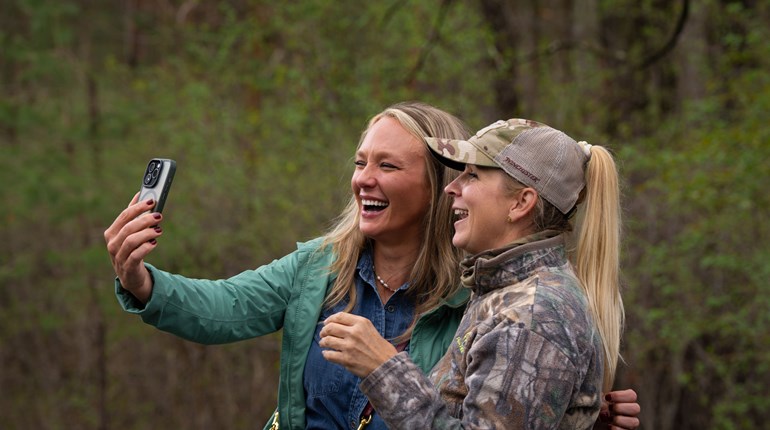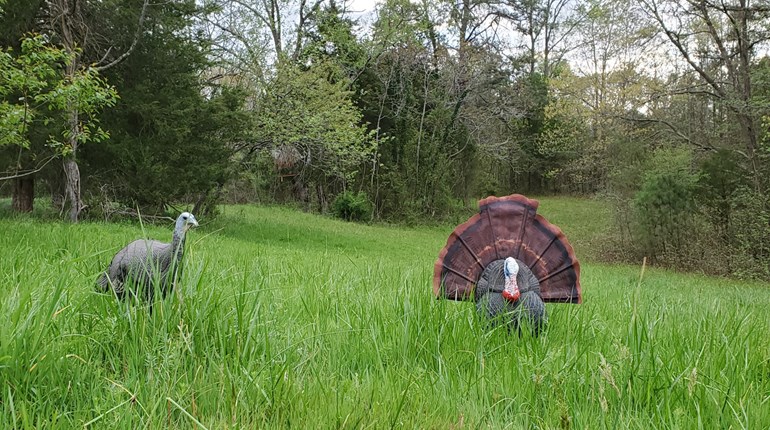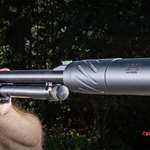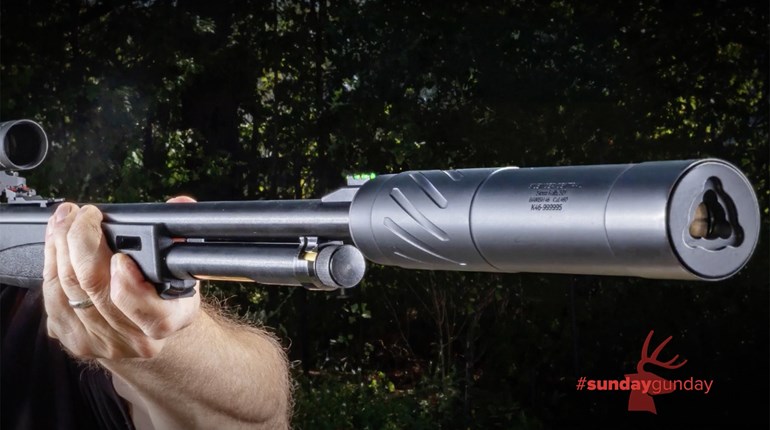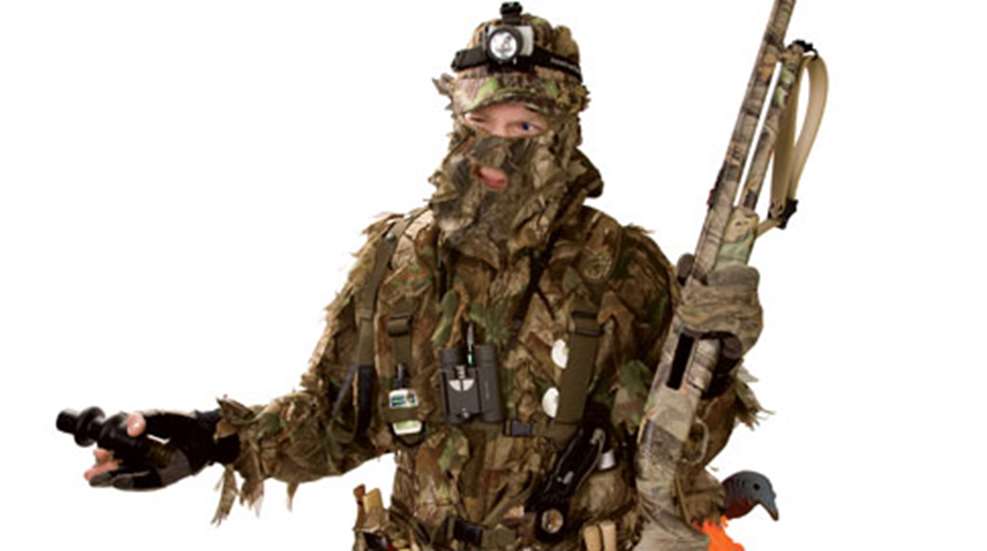
If an item ever helped me bag a turkey it tends to remain in my turkey kit for eternity. For example, a few years ago an ole’ boy at a gun show sold me a “turkey whistle.” He said it was like a dog whistle in that humans can’t hear it, but he guaranteed me that it’d shock a gobble right out of an old tom.
Having absolutely no success one afternoon with my traditional tricks, I patted myself down like an agent of the law, fumbled, frolicked and finally produced the turkey whistle. I sucked in a deep breath and blew that shiny little soundless pipe for all it was worth. I felt a little ridiculous when the only sound I heard as a result of almost $15 worth of my own breath was the blood pounding in my ears from head strain—no piercing whistle sound, no gobble, no nothing. Undeterred, I rocked back on my heels, pulled in another mammoth breath and exhaled like a warm-winded Jack Frost. I was looking at the whistle in my hand unbelievingly—much like an outfielder looks at his glove after he completely misses a pop fly—when I heard the distant rumblings of a gobbler. I never heard the turkey again, nor has my “magic turkey flute” worked since, but that’s beside the point. It worked once, and therefore it earned tenure in my vest, where it remains … somewhere.
And so it goes, collecting a gadget here, buying a new call there and stashing them in my vest until the burdensome amount of gear makes me feel like a WWII paratrooper in full combat gear. I trudge, hot as all get-out, amid the springtime woods, rattling and squawking with each heavy step. Soon my gear begins dictating my hunting style. There is something about a thick foam seat strapped to my backside that makes this once mobile turkey hunter want to take up a roost and make a bird come to me. A new decoy often makes me want to find the perfect place to set up a decoy (not necessarily the best place to take a real turkey); a call that sounds especially good makes me want to blow it even when I know I shouldn’t overcall. Realizing these temptations, I go back to the basics the following season.
On opening morning last year I stuffed a mere slate call in my pocket and a fistful of No. 6’s up a scattergun’s magazine. With liberated feet and a minimalist mind-set, I headed out before sunrise. But then I dropped my keys and needed a flashlight to find them. After a lot of crawling around I found them. I then stepped gingerly into the dark woods—and directly into a creek. I later used my hands and mouth, naturally, to hoot like an owl. But a fat gobbler—any gobbler—didn’t respond, likely because it wasn’t shocked by anything except how frail the owl sounded.
So I tried a yelp. A box call is much better for penetrating the woods over the stiff spring breeze than my slate call, but my high-volume paddle handle was resting quietly at home. No matter, I figured I’d use my wood-smarts to ambush a turkey on its own turf. I found a field where I knew turkeys to frequent, and I spotted three birds on the far, far end. During a 30-minute belly crawl,
I spooked three buzzards. These particular buzzards looked a heck of a lot like turkeys though.
Had I brought my dangly, pain-in-the-neck binocular I might’ve spotted their hideous, telltale buzzard beaks from afar. Thank gosh I didn’t encounter a copperhead while belly crawling, for I’d left my snakebite kit in the same pouch as my insect repellent. Yes, the insects had a field day on me that morning. And after following a forlorn sound of a lonely hen for hours, any chance of finding north—or more importantly the truck—without my compass was even less than the chance of me calling in a turkey when I noticed my pot call was a cauldron of boggy water. You guessed it: no sandpaper had I!
The next morning, I altered my strategy again. I vowed to take the things that I had a reasonably good chance of needing during the course of a hunt. But then I had trouble keeping my pants up with only my leather belt. So reluctantly I strapped on my vest, and I began transferring “just the essentials” from my person to its pockets. It is truly amazing what soon becomes labeled “essential” when you have a pocket that’s designed specifically for it.
Before long, I had come full circle. I shimmied off the drooping tailgate of my transport vehicle and sank into ground that wasn’t even that soft. But at least all my stuff was together and halfway organized, and I was prepared for whatever those treacherous turkeys slung at me, including machine gun fire. As I fumbled for my flashlight to find my GPS to find my way, I took comfort in knowing that I would not have to do another full circle to find the truck. Now if I could only find a turkey.
Nothin’ But the Essentials
License: You absolutely must have a state game license to hunt turkeys. I know this because every time I’ve hunted turkeys I’ve had a license on me. Since I hate to lose a good luck charm, I make copies of it and keep one in my pocket and one in my truck.
Shotgun: Whoever said they’d rather leave their gun than their binocular has obviously never had to shoot a turkey with a binocular. Any shotgun will work for turkeys, as long as you know its limitations. With that said, I prefer a 12-gauge, Benelli Super Black Eagle II ComforTech 3½-inch Advantage Max-4 HD camo with a full choke tube, a sling and fiber-optic sights. Please note that I have, at times, been accused of taking this stuff too seriously.
Shells: I’m a longtime fan of No. 6’s, but others prefer No. 4’s. Delivered directly to the face of a tom turkey, No. 5’s just might be perfect. When I get out of the truck, I load my gun, then I don’t have to worry about losing my shells.
Turkey Call: Pick one of umpteen different kinds and learn to scratch out a few sounds on it that will trick a turkey, then drop a mouth call in your shirt pocket, because if you have one people assume you know what you’re doing, and they don’t weigh anything anyway.
Camo Clothes
It is very likely that birds can see in color, scientists hypothesize. But I know they can. Movement—or lack thereof—plays a bigger role in bagging a tom than the color of your clothes, but I believe clothes that are the same color as trees, leaves and sticks look less like clothes to a turkey and more like trees, leaves and sticks. Camo helps to conceal movement from a bird that is actually looking for you to make sweet turkey love. This should be motivation enough for wearing camo. But if it’s not, there is also the humility aspect: If you’re a turkey hunter and you dress in blaze orange, your turkey-hunting friends will laugh at you.
Face mask: For Caucasians, those without facial hair or for those who are just plain ugly, a facemask conceals a glaring mug. It also hides movement from mouth calling, and, perhaps more importantly, guards against bugs. If only camo masks were socially acceptable ....
Camo gloves: Often my hands are the only things moving when I am calling a bird, or preparing to shoot. Therefore they should blend in with the woods. Buy a pair of camo gloves and wear them. I like to cut the thumb and first two fingertips off the glove so I can better feel the striker of my slate call. The only problem with camo gloves is that I’m always losing one in the woods, and then I have to buy two more of them.
Knife: You can’t call yourself a hunter if you don’t carry a knife. Trust me, the one time you don’t bring a knife is the time you’ll need it for notching your tag.
The Essentials-Plus
Vest/Cushion: If you do not plan on purchasing a vest, cease reading the rest of this gear list, as you will never be able to carry it all. Plus, vests store your gear and your bum-saver in one place—otherwise you wouldn’t be able to find it all before daylight to save your bum.
Extra Shells: I load my gun as much as the law will allow, then I throw three more shells in my vest. Last year, like an idiot, I forgot to load my gun when I got out of the truck. After hearing a turkey gobble and checking the chamber to discover it was empty, you can imagine my joy when I remembered the three reserve shells I had stashed in my vest for just such an occasion. Then imagine my disappointment when I didn’t get to fire any of them.
Additional Calls
In Virginia’s Thomas Jefferson National Forest I was half hunting, half scouting an area I’d never been to before and listening for a turkey to answer me. After wearing my trusty slate call thin, I’d just about crossed the area off my map with a big, rubber, “hopelessly devoid of turkeys” stamp, when, like Robert Redford in “The Natural,” I unsheathed my Moss’ double-tone box call, and after the first series of yelps, a turkey answered. This didn’t surprise me. It is a fact that certain turkeys in certain moods prefer certain calls. It is also a fact that I haven’t a clue when, why or how these certainties coincide. I was surprised, however, that the answer I received was in English: “Ain’t no use JJ,” yelled my estranged hunting partner, Lazy Eddie, as he rose from his sleep-still roost under an oak tree. “I believe we’s the only turkeys in these here woods!”
Slate Call: This is the sexiest sounding call and perhaps the most versatile. You can purr seductively, cutt aggressively, yelp longingly, cluck cluckingly and even putt on it. I don’t recommend putting on it often though, as golf is even more maddening than turkey hunting. A slate, or pot call, is easy to master and sounds very realistic. This go-to call has accounted for the mysterious disappearance of many a lonely tom. Put one in your vest pocket and frequently give it air.
Box Call: A great tool in the wind, its paddle provides leverage to bear down upon its two chalky tracks, providing ear-bleeding friction. It’s the loudest call commonly available, and it works great for calling in high winds or calling into places that require too much effort to venture. A word of warning about box calls: The sounds they make, like chalk boards, are naturally annoying to most people who do not religiously dress in camo—so practice only in designated areas.
Mouth Calls: In trained mouths a diaphragm call sounds as realistic as calls get—there’s something about a living being blowing air out of its mouth that makes the resulting noise sound alive. When I was younger, taller and my ears more keen, I believed I could tell the difference in any turkey caller and a real turkey, and with callers using slate and box calls I almost always can; however, I’d admit I’ve been fooled on in the woods by masters with mouth calls. But for every mouth-call master there is a legion of hacks who scare off more turkeys than they entice. (Believe me on this.) With much practice, eventually you’ll get a handle on your own mouth, and you’ll begin making sounds coherent to turkeys. Perhaps a mouth call’s biggest benefit is that it’s hands-free—you can practice in your truck and not get a ticket!
Owl Hooter: A hoot tube is loud, easy to use, and it’ll roust most sleeping gobblers. I think of it as a tom’s alarm clock: I hit the alarm, he hits the snooze until finally he flies down for a morning shower of No. 6’s. A blast from the old hoot horn is louder and carries farther than your voice, and unlike my outdated cupped-hand routine—it’s still good for impressing kids—you can use a hooter with one hand while wearing gloves and a mask.
Crow/Coyote Call: If the owl and the gobbler secretly swear to a pact of silence, don’t despair. The crow can’t keep his mouth shut to save the gobbler’s life. In yet tougher times, especially in the West, a coyote howler can shock a gobbler into revealing its position. If none of these work, try slamming a truck door at dusk before you drive home. That usually does the trick. If that doesn’t work, don’t cuss. I have scores of empirical evidence and documented proof that cussing turkeys does not do any good for filling your game bag, and may only make you feel better for a few fleeting seconds.
Decoy: In certain scenarios—such as when a cagey bird won’t cross an open field without visual confirmation—a decoy is essential. Whenever I can’t get a bird to come in, I tell my friends that if I had a decoy the bird would have come in. I truly believe that, and as a fortunate by-product, that belief makes me feel good.
Gun Sling: Take a good look at the pictures in this story. You see a bunch of gear, don’t you? A shotgun sling will free up your hands so you can carry it all.
Flashlight/Headlamp: Until oak trees are mandated by the government to come with Braille plaques—and you learn Braille—a flashlight is a very handy tool indeed. A headlamp is even better because it allows you to find—and carry—all your other stuff.
Binocular: Okay, maybe this item should be in the “gluttonous” category, but everytime I forget mine I wind up stalking buzzards. I don’t like buzzards.
Extra Strikers: I commonly lose my slate-call strikers in the woods. I think it’s because they look a lot like sticks. Finally I wised up and tied my striker to my slate call with a piece of string. Now if I lose a striker, I lose the call and the string. This forces me to be more mindful of my striker. For times when I lose the whole she-bang, however, I always keep a backup mouth call in my back pocket. If I lose my mouth call it means I’ve lost my backside. My momma told me this can’t happen.
Insect Repellant: Most times I go out, a swarm of small, winged insects hovers around my head like a stinging, buzzing raincloud. Ticks are bad enough, but a tick is a saint compared to the worst animal species on planet Earth: the silent, invisible, lowly, itchy and tender-part-be-derned chigger. If you’ve never seen one, it doesn’t mean they’re not plotting against you right now. Get some repellent, bathe in it and don’t worry about a thing … . (Deet was suspected of causing cancer in lab rats, not turkey hunters.)
The Gluttonous
Clippers: They’re useful for pruning saplings from your line of fire, and can make your sit more comfortable, but a necessity? Nope.
Turkey Wings: Wings are only good for simulating a morning fly-down and for carrying. Use your knife to lop a leafy limb, use it once, then throw it down.
Box Lunch: C’mon, if a good breakfast or a donut and coffee won’t stave off starvation before noon, perhaps you’re walking too much. Try calling for a change.
The Ridiculous
Full-body Mounted Turkey Decoy: These things are hideously expensive, extremely difficult to pack, and, what could be tougher than eating a stuffed decoy if you shoot it by mistake? I’ll tell you what: keeping a straight face while urging your buddies to go for seconds on the turkey and stuffing.
The Ultra-Ridiculous
Paid, Full-time Turkey Guide: These are great tools for getting you a turkey; every time I’ve been guided I believe I’ve shot a bird. But anyone can shoot a turkey; it’s hunting them that’s the challenge. Some of the best (and most ridiculous) turkey hunting experiences come from failure. If you’re new to turkey hunting, go back to the top of the list, gather up just the essentials and take to the woods. And for those of you who are turkey hunting fanatics … well, you’re ridiculous already.













